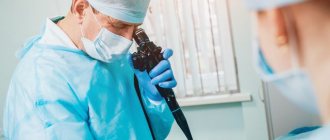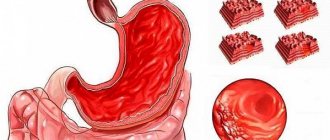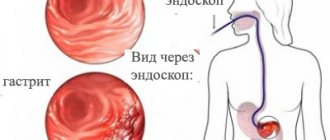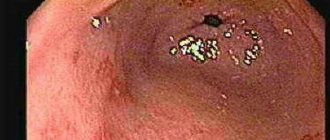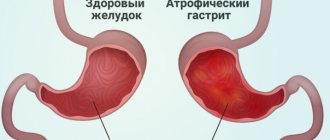Duodenal bulbitis: symptoms and treatment methods in adults
Few people have heard of such a pathological condition as stomach gulbit; they don’t know what it is. Although a disease such as bulbitis is extremely common. In fact, this pathology is just a type of inflammatory changes in the intestines.
Anatomically, in the duodenum there is a bulb into which the stomach directly passes and which can become inflamed separately. Bulbitis as a disease is diverse in morphological and clinical characteristics, but can be successfully treated with timely therapeutic compensation.
Causes
The causes of bulbitis are in many ways similar to the causes of gastritis:
- pharmaceuticals;
- chemical burns;
- love of alcoholic drinks;
- habit of eating too hot food;
- infection with helminths or lamblia (especially typical for children);
- variant of manifestation of Crohn's disease, etc.;
- poor nutrition (eating on the go, addiction to junk food, habit of eating once a day, but a lot, etc.);
- bacteria Helicobacter pylori (especially in the case of catarrhal form or mixed bulbitis);
- mechanical trauma to an organ (swallowing an indestructible object, which can damage the walls of the organ, often leading to focal damage).
Classification
Existing types of bulbitis are determined by the causes and nature of the development of the disease itself.
- Surface. With this type, the upper region of the mucosa is affected.
- Focal bulbitis is characterized by the accumulation of ulcerative formations. In this case, treatment is prescribed depending on the severity of the disease itself.
- Erosive. In this case, small ulcers may form on the mucous membrane.
- Hemorrhagic. With this type of bulbitis, inflammation of the mucous membrane, the appearance of erosions and bleeding are noted.
- Atrophic or bulbitis of the duodenum. This esophagitis causes pallor and thinning of the walls of the duodenum.
Forms
| Name | Manifestations |
| Surface | The deep layers of the mucosa are not affected by inflammation, there is no severe pain, and the general condition does not noticeably worsen. |
| Catarrhal bulbitis | Cramping abdominal pain, increased gas formation, nausea, weakness, and sometimes headaches. |
| Focal | Inflammation affects only certain parts of the duodenal bulb. The clinical picture is similar to the diffuse form. The location of the pain may shift. |
| Erythematous bulbopathy | The formation of red, swollen spots on the mucous membrane of the duodenum, strewn with small bleeding ulcers. There are traces of blood in the stool and vomit. |
| Erosive | Characterized by a severe course. On the inflamed mucosa there are shallow wounds (scratches, cracks), surrounded by edematous tissue that gathers into folds. The pain is more intense in the morning and evening hours. Nausea may be accompanied by vomiting and an attack of dizziness. Heartburn and belching of undigested food are possible. |
| Erosive-ulcerative | Ulcers form at the site of the wounds, causing severe pain on an empty stomach and after eating. There is a risk of bleeding in the duodenum, then feces and vomit become dark red or black. |
| Cicatricial (cicatricial-ulcerative deformity) | The result of illiterate treatment of duodenal ulcers. Scars form at the site of ulceration, leading to deterioration of peristalsis and patency. |
| Hyperplastic | It develops against the background of long-term inflammation, acquiring a lumpy appearance, which indicates tissue proliferation. May be caused by cancer. |
| Atrophic | The mucous membrane of the duodenum becomes thinner, which disrupts the functioning of the organ. There is frequent sour belching containing pieces of undigested food, heaviness and rumbling in the stomach and intestines, epigastric pain, and stool disturbances. |
| Follicular | Many bubbles form on the mucous membrane of the duodenum, which subsequently burst and transform into small ulcerations. |
When the pathology combines the manifestations of different types of bulbitis, it is called mixed bulbitis.
Symptoms of duodenal bulbitis
Bulbitis in adults is manifested by rather nonspecific symptoms, such as:
- feeling of nausea, bloating in the stomach;
- bitter or metallic taste in the mouth;
- headache and malaise (also with acute inflammation);
- pain in the epigastric region, more on the left, which can radiate to the left hypochondrium or umbilical region;
- rarely - vomiting (in case of acute poisoning or toxic infections, it can be repeated);
- diarrhea or loose stools.
A characteristic symptom of gastric bulbitis is the appearance of pain 1.5-2 hours after eating and at night. These are the so-called “hunger pains”, which decrease after taking milk or antacids. If bulbitis occurs as a manifestation of Crohn's disease, the severity of the symptoms evaluates the degree of activity of the inflammatory process. The following indicators are taken into account:
- frequency of diarrhea,
- intensity of abdominal pain,
- degree of weight loss, etc.
For example, with bulbitis of the 1st degree of activity, the patient’s well-being suffers little: diarrhea occurs 3-4 times a week, pain is minor and intermittent, and there is no weight loss.
What contributes to the development of duodenitis?
What diseases contribute to duodenitis? Giardiasis , ascariasis, chronic infection in the oral cavity, pharynx, genitals, gall bladder, and renal failure contribute to the development of duodenitis.
The inflammatory process can be sluggish, manifested by disturbances in appetite and general well-being, and mild dyspeptic symptoms. Patients experience lethargy and mental instability. Children grow up thin and develop poorly.
When infected with Giardia, the clinical picture of duodenitis can develop rapidly. Suddenly, usually after an error in diet, an attack of severe abdominal pain occurs, causing patients to squirm. The pain is not relieved by antispasmodics. The patient's face becomes hyperemic and becomes covered with drops of sweat.
Diagnostics
To confirm gastric bulbitis, the following methods are used:
- X-ray, which allows you to identify changes in the structure of the duodenum and stomach, confirming the existing symptoms. These are signs such as the presence of spasms turning into relaxation, instability of peristalsis, and increased size of the bulb.
- Physical examination by palpation of the abdomen. A possible diagnosis is indicated by the appearance of minor pain in the epigastric region and a tense state of the anterior abdominal wall.
- Daily pH-metry to track the dynamics of acid formation during meals, during a fasting state and in other situations.
- Electrogastroenterography, which makes it possible to detect signs of motor-evacuation abnormalities in the functioning of the stomach and duodenum.
- Duodenoscopy, which can reveal symptoms in the form of swelling and redness of the mucous membrane, its excessive bleeding, erosion areas in the lower part of the stomach and the adjacent part of the intestine. If the cause of the pathology is atrophy of the mucosa, it is possible to detect its pallor and thinning.
- Antroduodenal manometry to determine the pressure during contraction of the stomach during its operation (special sensors are placed in the antrum).
Drug treatment
Treatment using medications is prescribed only after determining the root cause of duodenal bulbitis. If it is focal and caused by the entry of a foreign object into the duodenum, then it is necessary to remove this object. As a rule, this can be done by duodenoscopy. When Helicobacter pylori infection is detected, combination therapy using antibiotics is prescribed. If the cause of the disease is a parasitic infestation, specialized treatment is carried out, which is prescribed depending on the type of parasite.
Steroid medications may be prescribed for Crohn's disease. Immunoregulators are used to treat follicular bulbitis. Symptomatic treatment helps alleviate the manifestation of the main signs of inflammation. Most often, antacids are used. H2 blockers and proton pump regulators may be used. If stress levels are elevated, sedatives may be prescribed to help relieve nervous tension.
Nutrition rules
Diet is the key to the effectiveness of treatment and the absence of relapses in the patient, so you need to pay special attention to nutrition. In severe advanced cases and in the acute stage, it is better to completely eliminate food intake for a while until pain, swelling and inflammation decrease, and then gradually add porridge with low-fat milk and water.
In the non-acute stage, nutrition for bulbitis includes fermented milk products, vegetable broths, and white bread crackers. All products must be boiled or steamed. The beneficial effects of natural jelly and enveloping cocktails. As a sweet treat, oatmeal cookies are perfect for such patients.
You should forever give up carbonated drinks, spicy and fried foods, and smoked foods. A patient with a predisposition to gastrointestinal diseases should never stop eating properly.
Fully or partially limited products
Excluded:
- Any broths, pickled and pickled vegetables, fried and spicy foods, fats, fatty meats, smoked meats and sausages, coarse meat with tendons.
- Vegetables, fruits and berries in raw form (during an exacerbation period). A little later they are introduced into the diet.
- Millet, pearl barley, barley, and corn cereals, which are considered difficult to digest.
- On an ongoing basis, mushrooms, onions, garlic, radishes, radishes. Legumes and white cabbage are limited if tolerated poorly.
- Fermented milk drinks with high acidity.
- Hot sauces, vinegar, pepper, spices, horseradish, mustard, ketchup, mayonnaise.
- Strong tea and coffee, any drinks containing gas, sour fruit juices, kvass.
Table of prohibited products
| Proteins, g | Fats, g | Carbohydrates, g | Calories, kcal | |
Vegetables and greens | ||||
| vegetables legumes | 9,1 | 1,6 | 27,0 | 168 |
| swede | 1,2 | 0,1 | 7,7 | 37 |
| cabbage | 1,8 | 0,1 | 4,7 | 27 |
| sauerkraut | 1,8 | 0,1 | 4,4 | 19 |
| green onion | 1,3 | 0,0 | 4,6 | 19 |
| bulb onions | 1,4 | 0,0 | 10,4 | 41 |
| cucumbers | 0,8 | 0,1 | 2,8 | 15 |
| canned cucumbers | 2,8 | 0,0 | 1,3 | 16 |
| white radish | 1,4 | 0,0 | 4,1 | 21 |
| turnip | 1,5 | 0,1 | 6,2 | 30 |
| canned tomatoes | 1,1 | 0,1 | 3,5 | 20 |
| horseradish | 3,2 | 0,4 | 10,5 | 56 |
| spinach | 2,9 | 0,3 | 2,0 | 22 |
| sorrel | 1,5 | 0,3 | 2,9 | 19 |
Mushrooms | ||||
| mushrooms | 3,5 | 2,0 | 2,5 | 30 |
Cereals and porridges | ||||
| corn grits | 8,3 | 1,2 | 75,0 | 337 |
| pearl barley | 9,3 | 1,1 | 73,7 | 320 |
| millet cereal | 11,5 | 3,3 | 69,3 | 348 |
| barley grits | 10,4 | 1,3 | 66,3 | 324 |
Confectionery | ||||
| candies | 4,3 | 19,8 | 67,5 | 453 |
Ice cream | ||||
| ice cream | 3,7 | 6,9 | 22,1 | 189 |
Cakes | ||||
| cake | 4,4 | 23,4 | 45,2 | 407 |
Raw materials and seasonings | ||||
| mustard | 5,7 | 6,4 | 22,0 | 162 |
| ginger | 1,8 | 0,8 | 15,8 | 80 |
| ketchup | 1,8 | 1,0 | 22,2 | 93 |
| mayonnaise | 2,4 | 67,0 | 3,9 | 627 |
| ground black pepper | 10,4 | 3,3 | 38,7 | 251 |
| chilli | 2,0 | 0,2 | 9,5 | 40 |
Dairy | ||||
| kefir | 3,4 | 2,0 | 4,7 | 51 |
| sour cream | 2,8 | 20,0 | 3,2 | 206 |
| curdled milk | 2,9 | 2,5 | 4,1 | 53 |
Meat products | ||||
| pork | 16,0 | 21,6 | 0,0 | 259 |
| ham | 22,6 | 20,9 | 0,0 | 279 |
Sausages | ||||
| dry-cured sausage | 24,1 | 38,3 | 1,0 | 455 |
| sausages | 10,1 | 31,6 | 1,9 | 332 |
| sausages | 12,3 | 25,3 | 0,0 | 277 |
Bird | ||||
| smoked chicken | 27,5 | 8,2 | 0,0 | 184 |
| duck | 16,5 | 61,2 | 0,0 | 346 |
| smoked duck | 19,0 | 28,4 | 0,0 | 337 |
| goose | 16,1 | 33,3 | 0,0 | 364 |
Fish and seafood | ||||
| dried fish | 17,5 | 4,6 | 0,0 | 139 |
| smoked fish | 26,8 | 9,9 | 0,0 | 196 |
| canned fish | 17,5 | 2,0 | 0,0 | 88 |
Oils and fats | ||||
| animal fat | 0,0 | 99,7 | 0,0 | 897 |
| cooking fat | 0,0 | 99,7 | 0,0 | 897 |
Non-alcoholic drinks | ||||
| bread kvass | 0,2 | 0,0 | 5,2 | 27 |
| black tea | 20,0 | 5,1 | 6,9 | 152 |
| * data is per 100 g of product | ||||
How to treat chronic bulbitis?
For chronic and catarrhal bulbitis, antibacterial therapy is prescribed, since this type of bulbitis develops, as a rule, due to Helicobacter pylori infection. Antibiotics are prescribed taking into account the sensitivity of the pathogen to them. These can be certain groups of antibiotics that act on the cell of the pathogen itself - Amoxicycline, Vilprafen, Summed, De-nol and others. Sometimes Metronidazole can be prescribed, but nowadays its effectiveness among potential “killers” of Helicobacter is disputed.
Also, with this type of bulbitis, a long-term diet is prescribed. In addition, you must stop smoking. Avoid stressful situations whenever possible. It is necessary to stop taking all kinds of food additives; they can also be a provoking factor for the exacerbation of catarrhal and chronic bulbitis. Also, in stressful situations, during the treatment of this type of bulbitis, sedatives and sedatives are prescribed.
You should understand and be psychologically prepared for the fact that you will have to reconsider your usual way of life, since the treatment will be complex and long-term.
Root Causes
This form of the disease is both chronic and acute in nature. Often, bulbitis occurs due to ulcerative pathologies. The acute form of the pathology occurs as a result of improper and unregulated nutrition, food poisoning, and regular exposure to alcohol. Also, one of the predisposing factors is damage to the duodenal mucosa by a foreign body.
The chronic form develops as primary and secondary forms of the disease. The precursors of a chronic primary disease are regular stress that the body experiences, problems with eating habits, and abuse of spicy foods.
Secondary bulbitis of a chronic nature can occur as a result of a pre-existing disease - chronic gastritis, ulcers or infection. Almost 70% of this pathology occurs when Helicobacter is activated. Infection most often occurs when the patient has antral gastritis. This is explained by the fact that the patient’s body begins to intensively produce pepsin, a violation of the integrity of the mucous bulb occurs, followed by the penetration of bacteria from the intestines.
An equally important cause remains short bowel syndrome. Occurs as a postoperative consequence during intestinal resection. The lack of sufficient amounts of essential substances that can regulate gastrin leads to increased inflammation.
Experts pay attention to the speed of movement of the food bolus through the intestines, since this is also an important factor in the development of primary bulbitis.
Prognosis and prevention
If you seek specialized help in a timely manner, prescribe adequate therapy for bulbitis and eradicate Helicobacter, the prognosis is favorable. Patients must follow dietary therapy recommendations and, if necessary, adjust their lifestyle. You should stop smoking and drinking alcohol.
Prevention of bulbitis involves timely treatment of gastritis with mandatory post-therapy tests confirming the eradication of the pathogen. Even without exacerbations, it is necessary to regularly attend medical examinations. Many drugs are aggressive to the mucous membrane of the stomach and duodenum, therefore, for bulbitis, all drugs should be used only after consultation with a doctor.
To prevent infection with Helicobacter, you should maintain food hygiene and wash your hands thoroughly before eating.
